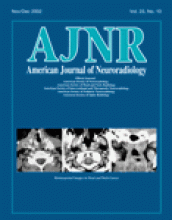Abstract
BACKGROUND AND PURPOSE: MR imaging is the method of choice for assessment in vivo of the development of myelination of the human central nervous system. During the first months of life, the myelination process follows well-defined steps, whereas little information exists about the later phases of myelination. To improve our understanding of this aspect and to identify the specific sites involved in the process of myelination in its terminal phase, we evaluated normal MR brain studies in children aged 20–40 months.
METHODS: We retrospectively evaluated 85 MR brain studies of 81 children aged 20–40 months who were without diseases potentially affecting white matter. The MR studies were performed with a 1.5-T system, with T2-weighted spin-echo and turbo spin-echo sequences. Subjective analysis of the signal intensity of the white matter was made in four areas: subcortical frontal, temporal, and parietal lobes and peritrigonal region. Extension of myelination was graded on an ordinal scale; 0 indicated the absence of myelin, and the maximum value indicated complete myelination.
RESULTS: A persistent T2 hyperintensity of the subcortical areas was noted after 20 months of age. With advancing age, a progressive increase in the grade of myelination was noted in these regions, and at about 40 months of age myelination was complete. However, in most of our patients aged 20 months, myelination in the peritrigonal areas appeared complete.
CONCLUSION: The only area that can still exhibit a persistent T2 hyperintensity on MR images at about 2 years of age is considered to be the peritrigonal region: the so-called terminal zone. At this age in our patients, however, a persistent T2 hyperintensity was noted in the frontotemporal subcortical regions. In these areas, the myelination appeared complete at 36–40 months of age. The so-called terminal zones were the subcortical areas rather than the peritrigonal area, and complete myelination took place by about age 3 years.
- Copyright © American Society of Neuroradiology












